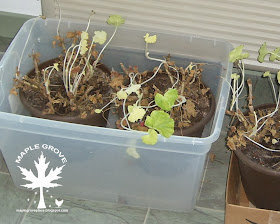Two of my favorite flowering plants are Hydrangeas and Geraniums. Hands down. No doubt about it. I'm not sure why. I think it's probably because of the lush green foliage and their large vibrant-colored blooms. I'm just really attracted to them. That, plus the fact that they are so easy to grow and take care of.
Hyndrangeas are perennials and come back every year. Geraniums are perennials in the warmer temperature zones, but in the northern areas like where I live in Pennsylvania, they are treated as annuals. I love them so much (and I love being thrifty and re-purposing whatever I can), so I over-winter my Geraniums and plant them again the next year. You can't do this with most annuals. But you can with Geraniums!
Winter Houseplants
There are a few different ways you can over-winter them.In each case, bring them in before the first frost. Cut the primary stems back to about four to six inches. If they are potted, you can bring the pots indoors, place them near a window with a southern exposure, and continue to water them and fertilize them throughout the winter. The first time I did this, they were very tall and leggy by spring, so I would recommend cutting them back a couple of times throughout the winter. (If you're digging them out of a garden bed, shake off the soil, and re-plant them in pots with clean potting mix to bring them indoors.)Dormant Storage in Pots
A second way to over-winter the Geraniums is to bring the trimmed plants in pots indoors and set them in a cool dark area (in a basement or a garage), and then just forget about them until spring. I liked this way better. They will go into a dormant state. In March, place the pots in a sunny room and begin watering them. This is what they will look like at that point:Soon they will being to sprout leaves. (They may even begin sprouting leaves before you bring them out of storage.)
On warm days, set them outside in the sun and start giving them some plant food.
By the time you're past your last frost date, you should have some healthy looking Geraniums.
You can leave them in the pots, transfer them into other pots with new potting soil, or plant them in the garden beds. I like them in both places!
Bare Root Storage
Another way to over-winter your Geraniums is to remove them from the pots or ground and shake the loose soil off of their roots.Trim the primary stems back to about four to six inches.
Place the plants in a loosely covered brown paper bag or a cardboard box with roots up (or hang them by the roots) in a cool, dark place, like a basement or a garage. Once a month, moisten the roots with water and return them to their storage. In the spring, plant them in pots in fresh potting soil, place them in a sunny room, and begin to water them.
Start New Plants with Cuttings
You can also start new plants by taking cuttings from healthy ones. Use clean shears to cut off a short piece of stem with a node (joint) and a few leaves. Plant the cutting in new potting mix. The roots will grow from the node. To promote a faster start, you can dip the node in a rooting hormone solution before planting. Add water and place the pots in plastic bags (but not tightly sealed) in a bright room, but not direct sunlight. Water as needed. In about a month you can transplant them into larger pots and continue to take care of them as houseplants. In the spring you'll have nice potted Geraniums.If you over-winter the same Geranium plants year after year, they will begin to get woody with fewer blooms. At that point, you may want to replace them with new plants. For lots of blooms on your Geraniums, cut the dead blooms off to promote new ones. Have fun experimenting, and enjoy your lovely Geraniums!










